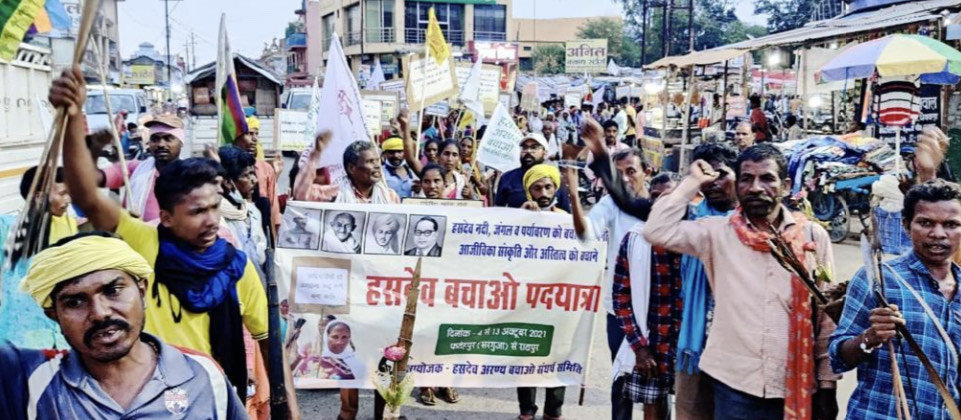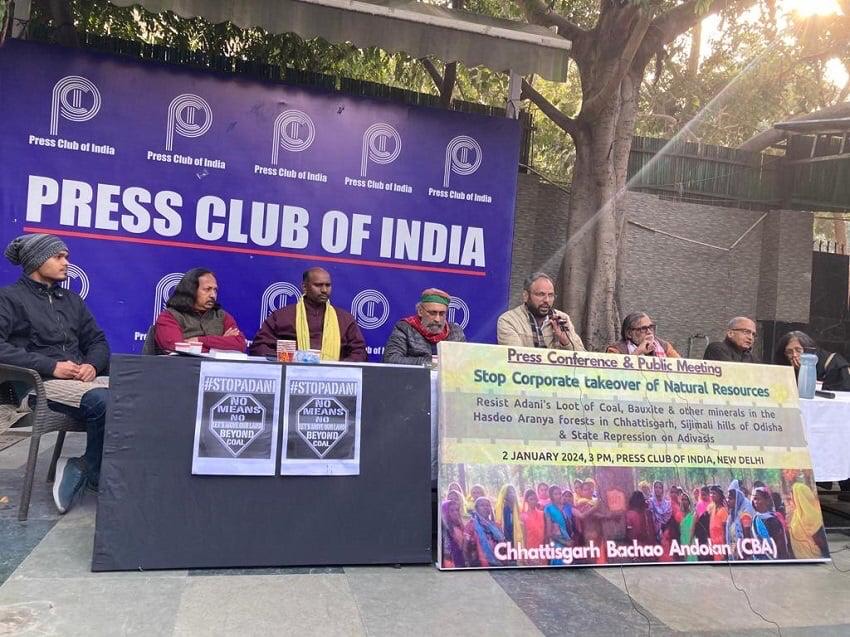Located in Chhattisgarh, the Hasdeo Aranya forests are rich in biodiversity. Here is also a habitat that is home for thousands of indigenous Adivasi communities. Yet, unchecked and ongoing, coal mining projects in the areas have resulted in the felling of large numbers of trees and the enforced displacement of the indigenous population.
On the one hand. while the local Adivasi community-led protests are being suppressed by the state government, the establishment –regardless of which party is in power, Indian National Congress (INC) or the Bharatiya Janata Party (BJP) –is adamant on continuing the coal mining project.
Adivasi activists have alleged that the newly elected BJP government in the state has handed over thousands of hectares of forest lands to big corporate players. It is feared that these state-imposed policies may lead to further displacement of the indigenous community in the state.
While axes fell the trees in Surguja districts in Chhattisgarh, it is police batons that are raining violence on the protesting Adivasis. News of large numbers of recent arrests of Adivasi activists by the police has also been documented.
Given the huge protests, the state government has also arranged for a large deployment of security forces in the areas. Instead of initiating a dialogue and addressing the growing discontent of the people, the BJP government has approached the issue by intensifying armed security.
According to the indigenous activists, both the police and the local administration are threatening the local Adivasi community against raising their voices against the ongoing deforestation projects. They have alleged that the local administration has been instructed by the state government to deal firmly with the protestors. –
The state government’s repressive policy is a tool to generate fear among the protestors, who are waging a life and death battle les against the greed-propelled and ecologically unfriendly models of development.
But Chief Minister Vishnu Deo Sai has, so far, appeared to be in denial mode by saying that so far no arrest had been made. He is unwilling to engage with the allegations that his government has failed to involve the indigenous community in the developmental process. Even the Constitutionally-mandated laws giving special protection to the Adivasi community and the resources in their areas have been bypassed to facilitate the plunder of the natural resources.
For example, a news story by the news agency PTI revealed that the state government has handed over a thousand hectares of forest lands for mining in the Surguja district to corporate players, triggering wide-scale protests. The Hasdeo Arand Bachao Sangharsh Smiti, which is led by the Adivasi community, has been raising voices against the handing over of the forest lands to corporate players.
The voices of protests against the deforestation of the Hasdeo forest are also being echoed in different places in the country.
A public meeting was held in New Delhi’s Press Club of India on January 2 during which a large number of activists, civil society members and intellectuals, united under the banner of Chhattisgarh Bachao Andolan (CBA), expressed their deep concern about “corporate takeover” of the natural resources.
Prominent among those who attended this press conference were Alok Shukla (Chhattisgarh Bachao Andolan), Thawar Chand Meena (MLA from Dhariawad, Rajasthan), Umeshwar Singh Armo (Hasdeo Aranya Bachao Sangharsh Samiti), Prashant Bhushan (Supreme court advocate), Prafulla Samantray (activist), Sudiep Shrivastava (Chhattisgarh High Court advocate) Paranjoy Guha Thakurta ( author and journalist) and Professor Nandini Sundar (University of Delhi).
At the Press Club of India, the activists and the civil society members rightly linked the fight to save Hasdeo Aranya forest to other struggles to save nature and the life of the Adivasi community across the country. According to them, the corporate loot of minerals including coal and bauxite is happening at various places in India, particularly in the Adivasi regions.
History is witness to the fact that since the colonial era, the vicious cycle of the exploitation of natural resources from the Adivasi areas and the displacement of the indigenous population has not stopped.
The rise of the modern state and the profit-based economic model are some of the major factors for the destruction of the environment and the attacks on the indigenous community. With the introduction of the institution of private property during colonial time, the landlords, moneylenders and colonial administrators penetrated the Adivasi region to inflict ruins on them.
Such exploitative colonial policies supported by the native landlords and money lenders were vigorously opposed by a series of revolts by the Adivasi community. One of them was led by Birsa Munda in the last phase of the nineteenth century. Birsa’s struggles were aimed at achieving self-rule for the Adivasi community and autonomy in their regions.
After Independence, the promises made to the Adivasi community were largely forgotten. It was the Adivasi region which was chosen for the construction of the large-scale dams and the mining projects. This led to the destruction of the environment, loss of biodiversity and the displacement of the Adivasi community on a large scale.
While the migration of non-Adivasi outsiders to the Adivasi areas has been substantial, leading to ae change in the demography, the ongoing policies of deforestation, mining and industrialization have also rendered Adivasis homeless, forcing them to migrate to urban areas where they have no social security. Nor are they often recognized as the Scheduled Tribes (ST) by the state.
Undoubtedly, the Adivasi community has been the worst sufferers of the developmental projects. The Constitution’s provisions for the protection of the Adivasi community continued to be violated to facilitate the corporate plunder of the resources. Worse still, the consent of the Adivasi community for the developmental project is either bypassed or obtained through coercive methods. Sadly, regions in central India, dominated by the indigenous Adivasi population are also among the most heavily militarised by the state. Yet, on the human development index, the same regions fall behind, are the most backward regions.
What is happening with the Hasdeo Aranya forests is the cruel continuation of the process of colonisation in the Adivasi areas. But sooner or later such anti-Adivasi policy must stop to ensure the will of the people, and the future of Indian democracy.
(Dr Abhay Kumar is a Delhi-based journalist. He has taught political sciences at NCWEB Centres of Delhi University.)
Disclaimer: Views and opinions expressed in this article is solely that of the author and does not necessarily reflect the views or position of Sabrang India and this site.



